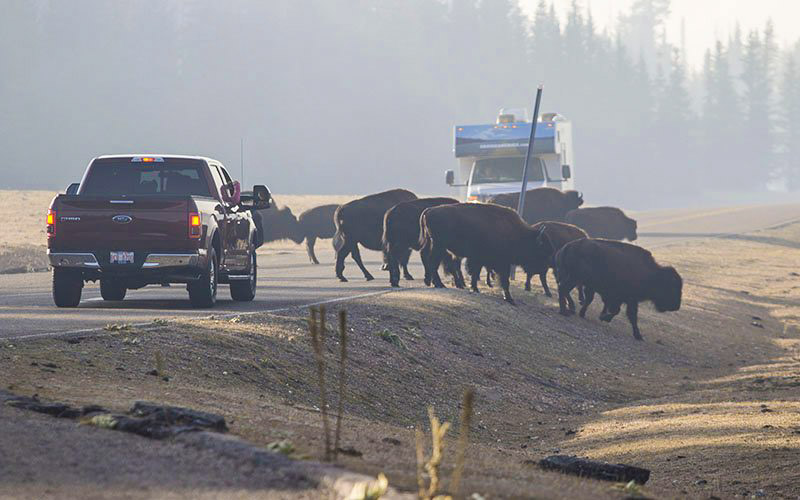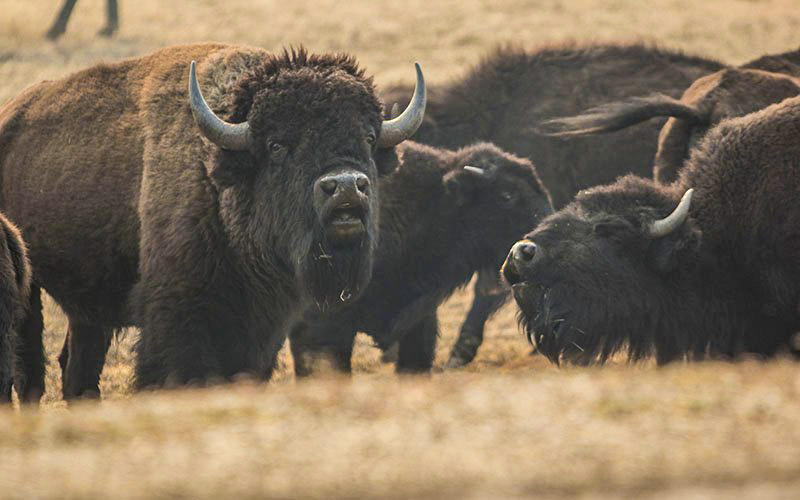Indianz.Com > News > Cronkite News: Plan calls for hunting of bison in Grand Canyon

Sharpshooters could target Grand Canyon bison by 2021 under herd plan
Monday, October 12, 2020
Cronkite News
WASHINGTON – State and federal officials have agreed on a plan that includes bringing in volunteer sharpshooters to cut the number of bison on the North Rim of the Grand Canyon.
Lethal removal has long been discussed as a way to reduce the herd, along with hazing and relocation, but the
September 25 agreement
between the Arizona Game and Fish Department and the National Park Service clears a path for it to begin as soon as next year.
Scott Poppenberger, Flagstaff regional supervisor for the Arizona Game and Fish Department, said “the lethal removal component is a big part of this recent agreement,” and believes that the measures to reduce the population will help provide balance to the damaged ecosystem.
It comes amid growing concerns from the public and the park service about the impact the nonnative bison have on natural resources, and worries that they could pose a danger to park visitors.
The animals, descended from early 20th-century attempts to cross-breed cattle and bison, have proliferated in the Grand Canyon National Park, where they currently cannot be hunted. The goal of the agreement is to reduce the current herd of 400 to 600 bison to as few as 200, which would do less damage to the environment. “In the absence of any large carnivores, or sufficient natural mortality, people really have to step in and make sure that these different ecosystems, from wildlife, to plant life, and everything else requires some management to stay functional and stay in balance,” Poppenberger said. “And lethal removal is a part of the environment, it’s a part of the ecosystem.” Relocation has been one main strategy for herd reduction – over the past two years the park service worked with the Intertribal Buffalo Council to capture and relocate 88 bison to five tribes as additions to their existing herds. But with the September agreement, volunteer sharpshooters will be randomly selected and put through a background check and a firearms proficiency check to help cull the herd.Grand Canyon wildlife managers relocated 57 bison from the North Rim last week to reduce the herd of up to 600. All were trucked by the Intertribal Buffalo Council to the Prairie Band Potawatomi Nation, Flandreau Santee Sioux Tribe, Santee Sioux Tribe & Modoc Nation. (NPS photo) pic.twitter.com/ZwqeXiG9P2
— Peter Corbett (@PeterCorbett1) September 10, 2020

It’s not the ethical implications that worry Trudeau, but the use of volunteer sharpshooters that he thinks could open the door to hunting at other parks. “It’s a precedent. Which park is next?” Trudeau said, “Are there going to be efforts to hunt pronghorn over in the Petrified Forest national park? Are we going to have to open up a mule deer hunting season down in Saguaro National Park? “Once you open up the potential for a hunt, in national parks, the genie is out of the bottle,” he said. For more stories from Cronkite News, visit cronkitenews.azpbs.org.“I’m tired of Ted Turner making all the money on the buffalo,” Rep. Don Young (R-AK) tells National Congress of American Indians. Young introduced H.R.5153, Indian Buffalo Management Act, to restore buffalo populations on tribal lands. Hearing was Feb 5. #ECWS2020 @repdonyoung pic.twitter.com/bCjqefJvE1
— indianz.com (@indianz) February 11, 2020
Note: This story originally appeared on Cronkite News. It is published via a Creative Commons license. Cronkite News is produced by the Walter Cronkite School of Journalism and Mass Communication at Arizona State University.
Search
Filed Under
Tags
More Headlines
NAFOA: 5 Things You Need to Know this Week (March 31, 2025)
Chuck Hoskin: Cherokee Nation celebrates Cherokee women
Native America Calling: Tribal rights, a new restaurant and more are on The Menu
Native America Calling: Tribes vie for better access to traditional plants
Senate committee schedules confirmation hearing for Interior nominee
Fact Sheet: Department of Health and Human Services to undergo ‘dramatic restructuring’
Press Release: Department of Health and Human Services to undergo ‘dramatic restructuring’
Native America Calling: The new Social Security reality for Native elders
Montana Free Press: Hip-hop artist Foreshadow celebrates latest release
Cronkite News: Bill creates alert system for missing and murdered relatives
Bureau of Indian Affairs approves HEARTH Act regulations for Mohegan Tribe
House Subcommittee on Indian and Insular Affairs sets field hearing for self-determination anniversary
Native America Calling: Sometimes, COVID doesn’t go away
Native America Calling: The changing landscape for subsistence hunting and fishing
Press Release: AIHEC ‘deeply concerned’ about closure of Department of Education
More Headlines
Chuck Hoskin: Cherokee Nation celebrates Cherokee women
Native America Calling: Tribal rights, a new restaurant and more are on The Menu
Native America Calling: Tribes vie for better access to traditional plants
Senate committee schedules confirmation hearing for Interior nominee
Fact Sheet: Department of Health and Human Services to undergo ‘dramatic restructuring’
Press Release: Department of Health and Human Services to undergo ‘dramatic restructuring’
Native America Calling: The new Social Security reality for Native elders
Montana Free Press: Hip-hop artist Foreshadow celebrates latest release
Cronkite News: Bill creates alert system for missing and murdered relatives
Bureau of Indian Affairs approves HEARTH Act regulations for Mohegan Tribe
House Subcommittee on Indian and Insular Affairs sets field hearing for self-determination anniversary
Native America Calling: Sometimes, COVID doesn’t go away
Native America Calling: The changing landscape for subsistence hunting and fishing
Press Release: AIHEC ‘deeply concerned’ about closure of Department of Education
More Headlines